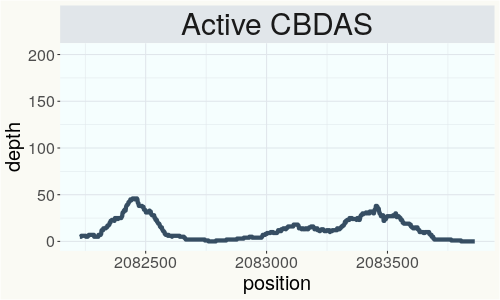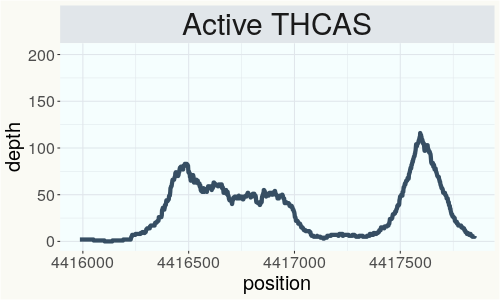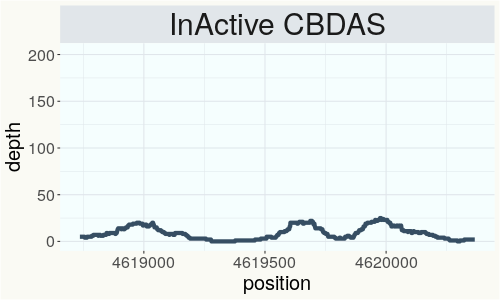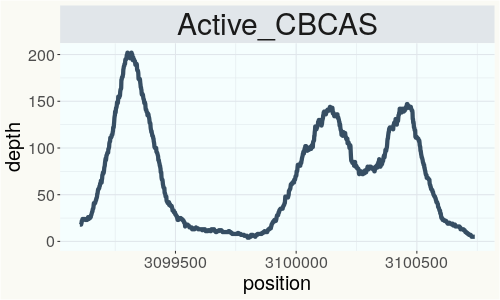JL Cross 21
RSP 11522
Grower: Kevin McKernan
General Information
- Accession Date
- June 17, 2020
- Reported Plant Sex
- not reported
- Report Type
- StrainSEEK v2 3.2Mb
- DNA Extracted From
- Unknown
The strain rarity visualization shows how distant the strain is from the other cultivars in the Kannapedia database. The y-axis represents genetic distance, getting farther as you go up. The width of the visualization at any position along the y-axis shows how many strains there are in the database at that genetic distance. So, a common strain will have a more bottom-heavy shape, while uncommon and rare cultivars will have a visualization that is generally shifted towards the top.
Chemical Information
Cannabinoid and terpenoid information provided by the grower.
Cannabinoids
No information provided.
Terpenoids
No information provided.
Genetic Information
- Plant Type
- Type II
File Downloads
The bell curve in the heterozygosity visualization shows the distribution of heterozygosity levels for cannabis cultivars in the Kannapedia database. The green line shows where this particular strain fits within the distribution. Heterozygosity is associated with heterosis (aka hybrid vigor) but also leads to the production of more variable offspring. When plants have two genetically different parents, heterozygosity levels will be higher than if it has been inbred or backcrossed repeatedly.
The ratio of reads mapped to Y-contigs to reads mapped to the whole Cannabis genome (Y-ratios) has been demonstrated to be strongly correlated with plant sex typing. This plot shows the distribution of Y-ratios for all samples in our database which were sequenced with the same method (panel or WGS) as this sample and where this sample falls in the distribution.

This chart represents the Illumina sequence coverage over the Bt/Bd allele. These are the three regions in the cannabis genome that impact THCA, CBDA, CBGA production. Coverage over the Active CBDAS gene is highly correlated with Type II and Type III plants as described by Etienne de Meijer. Coverage over the THCA gene is highly correlated with Type I and Type II plants but is anti-correlated with Type III plants. Type I plants require coverage over the inactive CBDA loci and no coverage over the Active CBDA gene. Lack of coverage over the Active CBDA and Active THCA allele are presumed to be Type IV plants (CBGA dominant). While deletions of entire THCAS and CBDAS genes are the most common Bt:Bd alleles observed, it is possible to have plants with these genes where functional expression of the enzyme is disrupted by deactivating point mutations (Kojoma et al. 2006).



This chart represents the Illumina sequence coverage over the CBCA synthase gene.

Variants (THCAS, CBDAS, and CBCAS)
No variants to report
Variants (Select Genes of Interest)
| PKSG-2a | c.774G>A | p.Met258Ile | missense variant | moderate | contig700 | 1944616 | C/T |
|
| PKSG-2a | c.67T>A | p.Phe23Ile | missense variant | moderate | contig700 | 1945567 | A/T | |
| PKSG-2a | c.31A>T | p.Thr11Ser | missense variant | moderate | contig700 | 1945603 | T/A | |
| PKSG-2b | c.1152T>A | p.Asn384Lys | missense variant | moderate | contig700 | 1950486 | A/T | |
| PKSG-2b | c.1132C>G | p.Leu378Val | missense variant | moderate | contig700 | 1950506 | G/C |
|
| PKSG-2b | c.1117A>G | p.Ile373Val | missense variant | moderate | contig700 | 1950521 | T/C | |
| PKSG-2b | c.774G>A | p.Met258Ile | missense variant | moderate | contig700 | 1950864 | C/T | |
| PKSG-2b | c.31A>T | p.Thr11Ser | missense variant | moderate | contig700 | 1951851 | T/A | |
| PKSG-4b |
c.535_545del |
p.Ile179fs | frameshift variant | high | contig700 | 2721127 |
CCCCACTCCAAT |
|
| PKSG-4b | c.523C>T | p.His175Tyr | missense variant | moderate | contig700 | 2721150 | G/A | |
| PKSG-4b | c.489delT | p.Phe163fs | frameshift variant | high | contig700 | 2721183 | CA/C | |
| PKSG-4b |
c.353_354ins |
p.Gly119fs | frameshift variant | high | contig700 | 2721319 | T/TGG |
|
| DXR-2 | c.1319T>C | p.Ile440Thr | missense variant | moderate | contig380 | 285250 | A/G |
|
| DXR-2 | c.431C>G | p.Ala144Gly | missense variant | moderate | contig380 | 287760 | G/C | |
| aPT4 | c.775delT | p.Tyr259fs | frameshift variant | high | contig121 | 2831380 | AT/A |
|
| aPT4 | c.1168T>C | p.Tyr390His | missense variant | moderate | contig121 | 2833503 | T/C |
|
| aPT1 | c.406A>G | p.Ile136Val | missense variant | moderate | contig121 | 2839605 | A/G | |
| aPT1 | c.629C>T | p.Thr210Ile | missense variant | moderate | contig121 | 2840237 | C/T | |
| HDS-2 |
c.82_93delGT |
p.Val28_Thr3 |
conservative inframe deletion | moderate | contig95 | 1989748 |
CGTAACCGGAAC |
|
| HDS-2 | c.127T>G | p.Ser43Ala | missense variant | moderate | contig95 | 1989794 | T/G |
|
Nearest genetic relatives (All Samples)
- 0.049 JL X NSPM1 7 (RSP11469)
- 0.056 JL Tent 2 (RSP11489)
- 0.069 JL Cross 19 (RSP11520)
- 0.069 JL Tent 3 (RSP11490)
- 0.071 JL Cross 9 (RSP11510)
- 0.076 JL X NSPM1 14 (RSP11473)
- 0.079 JL Cross 18 (RSP11519)
- 0.082 JL Cross 26 (RSP11527)
- 0.091 JL X NSPM1 11 (RSP11471)
- 0.091 JL Cross 23 (RSP11524)
- 0.092 JL Cross 17 (RSP11518)
- 0.097 JL x NSPM1 1 (RSP11478)
- 0.103 JL Cross 2 (RSP11503)
- 0.104 JL x NSPM1 1 5 (RSP11479)
- 0.105 JL Cross 28 (RSP11529)
- 0.106 JL Cross 15 (RSP11516)
- 0.108 JL X NSPM1 21 (RSP11474)
- 0.112 JL Cross 27 (RSP11528)
- 0.118 JL x NSPM1 3 (RSP11481)
- 0.118 JL X NSPM1 5 (RSP11467)
Most genetically distant strains (All Samples)
- 0.444 80E (RSP11213)
- 0.444 Northern Lights (RSP11501)
- 0.442 Cbot-2019-005 (RSP11133)
- 0.430 80E (RSP11212)
- 0.428 BagSeed (RSP12627)
- 0.428 CS (RSP11208)
- 0.415 R3in134 (SRR14708235)
- 0.414 Carmaleonte (RSP11207)
- 0.414 R1in136 (SRR14708226)
- 0.413 80E (RSP11211)
- 0.412 Ruderalis Indica (SRR14708267)
- 0.412 Right Mark (RSP11628)
- 0.411 Feral (RSP11205)
- 0.409 Abacus (RSP11266)
- 0.409 Chem 91 (RSP11185)
- 0.407 RKM-2018-012 (RSP11103)
- 0.407 R1in136 (SRR14708237)
- 0.406 IUP3 (SRR14708256)
- 0.406 Squirrel Tail -81- (RSP11622)
- 0.405 IBE (SRR14708228)
Nearest genetic relative in Phylos dataset
- Overlapping SNPs:
- 71
- Concordance:
- 47
Nearest genetic relative in Lynch dataset
- Overlapping SNPs:
- 3
- Concordance:
- 3
Blockchain Registration Information
- SHASUM Hash
-
becc5719f62a25ba0a3840b2028abd5c 777b0d4ec8ce7646 48ca3a47d3799e41